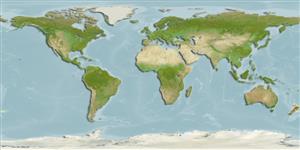Classification / Names
Κοινά ονόματα | Συνώνυμα | Catalog of Fishes(Γένος, Είδη) | ITIS | CoL | WoRMS | Cloffa
>
Ophidiiformes (Cusk eels) >
Carapidae (Pearlfishes) > Carapinae
Etymology: Echiodon: Greek, echieys, eos = a little viper + Greek, odous = teeth (Ref. 45335); prionodon: Name from Greek 'priôn' meaning saw, and 'odous' (odon) meaning tooth, referring to the unique
morphology of the fang at the tip of the jaw..
Environment: milieu / climate zone / depth range / distribution range
Οικολογία
Θαλασσινό(ά); εύρος βάθους 37 - 313 m (Ref. 93132). Temperate
Southwestern Pacific: New Zealand.
Μέγεθος / Βάρος / Age
Maturity: Lm ? range ? - ? cm
Max length : 16.5 cm TL αρσενικό/απροσδιόριστο; (Ref. 93132)
Short description
Μορφολογία | Μορφομετρία
This species is distinguished by the following characters: serrated posterior margin on the fangs; expanded thoracic plates on some abdominal vertebrae, 33-35 precaudal vertebrae; 42-45 dorsal-fin rays anterior to vertical through vertebrae 30 and 31; 40-41 anal-fin rays anterior to vertical through articulation between vertebrae 30 and 31 (Ref. 93132).
Life cycle and mating behavior
Γεννητική Ωρίμανση | Αναπαραγωγή | Γεννοβολία | Αβγά | Γονιμότητα | Προνύμφες
Parmentier, E., 2012. Echiodon prionodon, a new species of Carapidae (Pisces, Ophidiiformes) from New Zealand. European Journal of Taxonomy 31:1-8. (Ref. 93132)
IUCN Red List Status (Ref. 130435)
Threat to humans
Harmless
Human uses
Περισσότερες πληροφορίες
Κοινά ονόματαΣυνώνυμαΜεταβολισμόςΘηρευτέςΟικοτοξικολογίαΑναπαραγωγήΓεννητική ΩρίμανσηΓεννοβολίαΣυναθροίσεις γεννοβολίαςΓονιμότηταΑβγάEgg development
Age/SizeΑύξησηLength-weightLength-lengthLength-frequenciesΜορφομετρίαΜορφολογίαΠρονύμφεςΔυναμική προνυμφώνΣτρατολόγησηΑφθονίαBRUVS
ΑναφορέςΥδατοκαλλιέργειεςΠροφίλ υδατοκαλλιέργειαςΣτελέχοιΓενετικήElectrophoresesΚληρονομικότηταΑσθένειεςΜεταποίησηNutrientsMass conversion
ΣυνεργάτεςΦωτογραφίεςStamps, Coins Misc.ΉχοιΣιγκουατέραΤαχύτηταΚολυμβητικός ΤύποςΕπιφάνεια βραγχίωνOtolithsΕγκέφαλοιΌραση
Εργαλεία
Special reports
Download XML
Διαδικτυακές πηγές
Estimates based on models
Preferred temperature (Ref.
123201): 12 - 16.5, mean 14.3 °C (based on 27 cells).
Phylogenetic diversity index (Ref.
82804): PD
50 = 0.5001 [Uniqueness, from 0.5 = low to 2.0 = high].
Bayesian length-weight: a=0.00102 (0.00046 - 0.00225), b=3.06 (2.88 - 3.24), in cm total length, based on all LWR estimates for this body shape (Ref.
93245).
Τροφικό Επίπεδο (Ref.
69278): 3.6 ±0.5 se; based on size and trophs of closest relatives
Fishing Vulnerability (Ref.
59153): Low vulnerability (10 of 100).
